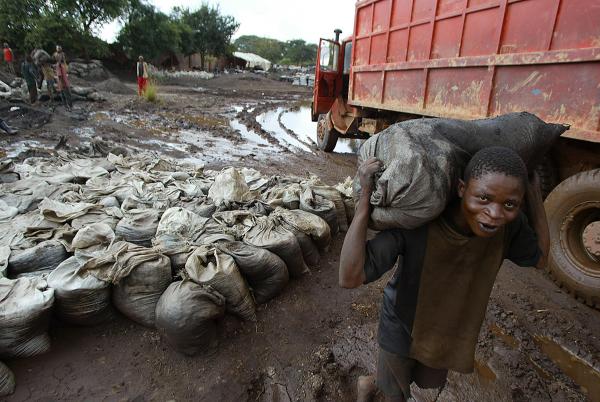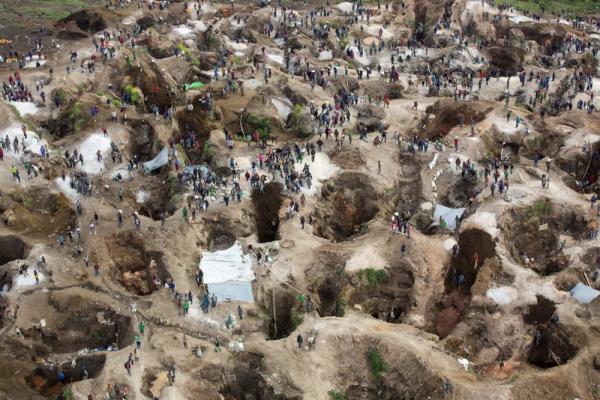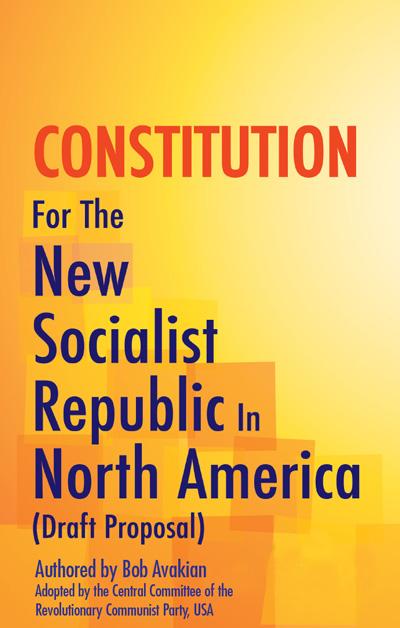
40,000 children dig tunnels and haul rocks from cobalt mines in the Democratic Republic of Congo. Cobalt is an essential mineral for the lithium-ion batteries used in electric vehicles, laptops and smart phones. Photo: AP
Some people who have devoted their lives to working for the environment have argued for years about how the emergence of commercial solar power and new, cheaper batteries to store electricity will provide, at last, a real and practical solution to the onrushing climate catastrophe. They have also argued that with the cheapening and spread of renewable energies, like wind and solar power generation, the capitalists who run the world will find it profitable and desirable to make a massive shift to these technologies. And these capitalists will essentially stop burning fossil fuels like oil and coal that drive climate change.
Some in the environmental movement have argued that even if the capitalists won't “come around” on their own—they can be pushed towards a total “clean energy” overhaul through mass pressure and popular campaigns. The take-home message is that this can be done within the framework of this system—and is really the only practical way human society can respond to the climate catastrophe.1 (Renewable energies like solar and wind power are called “clean” because they don't directly pollute and emit carbon that traps heat in the atmosphere and lead to global temperature rise.)
Here is an “inconvenient truth”: for all the technical advances of renewable energy and all the hoopla over electric vehicles, fossil fuels still account for some 80 percent (!) of U.S. energy consumption. That is a disaster for the planet in itself. Other articles on revcom.us have analyzed why fossil fuels are so essential to the profitable functioning and strategic needs of U.S. imperialism.
Here our focus is on some of the “dirty little secrets” behind “clean energy.”
A Basic and Oppressive Division in the World
Technologies like solar panels or electric cars reduce carbon emissions. But under this capitalist-imperialist system, the production of this technology is carried out through, and reinforces, a profoundly oppressive and unequal division in the world: the division between the rich capitalist-imperialist countries and the impoverished, oppressed countries of the global South, where the great majority of humanity lives.
You have a situation where most of the “consumers” of electric vehicles are concentrated in the developed capitalist countries, while most of the extraction of the raw materials required for the batteries that power them is concentrated in a number of oppressed countries of the global South.
The process of making things like the batteries essential to electric cars rests on brutal and horrific exploitation and massive environmental degradation. A horrific example of the reality behind so-called “clean energy” is the story of cobalt mining in the Democratic Republic of the Congo in central Africa.
Cobalt is a mineral essential to advanced batteries in widespread use today: in smart phones, laptops, and in electric cars. Without cobalt, batteries have to be twice as large to maintain the same storage capacity. Seventy percent of the cobalt mined in the world today comes from the Congo.2 It is estimated that 30 times more cobalt, along with lithium, nickel, and other key minerals used in electric vehicles, may be required by 2040 as the markets for these vehicles grow.
Imperialist Domination, Civil Wars, and Plunder of the Democratic Republic of the Congo
The Democratic Republic of the Congo (DRC) is one of the richest countries in the world in terms of mineral wealth. Copper, cobalt, nickel, gold, diamonds and much more. But since the days of the slave trade, the country’s riches and its people have been plundered relentlessly.3 One observer noted, “In Congo, more than 85 percent of people work informally, in precarious jobs that pay little, and the cost of living is remarkably high: because the country’s infrastructure has been ravaged by decades of dictatorship, civil war, and corruption, there is little agriculture, and food and other basic goods are often imported.”4
This is because of the domination exercised by foreign imperialist powers over countries like the DRC... the structuring of that economy to serve imperialist profit... and the support for (or forceful installation of) “friendly” governments that act as “client regimes” for imperialists.
There are over 100 armed groups operating in the Congo, some backed by imperialist powers, some by neighboring countries, some arising from religious and ethnic rivalries. The government can’t stop these groups, while at the same time it tries to use them to serve its repressive ends. These groups fight each other and prey on the masses of people. Some of the groups actually own, control and profit from cobalt mines.
Five million people have been killed in the internal wars in the Congo. This is a hidden part (to most of the population in the U.S.) of the lethal reality behind the production of batteries for electric cars. There is more...
Most of the mining of cobalt is done by major international corporations, but estimates are that between 15 and 30 percent of the cobalt mined in the Congo comes from what are called “artisanal mines,” which basically means impoverished miners go out and dig their own mines with hand tools.
Child Labor in Congo's Mines

40,000 children dig tunnels and haul rocks from cobalt mines in the Democratic Republic of Congo. Cobalt is an essential mineral for the lithium-ion batteries. Here, children labor in the Congo cobalt mines. Photo: PD
Here is the story of one such mine from The New Yorker:
In Kolwezi, children as young as three learn to pick out the purest ore from rock slabs. Soon enough, they are lugging ore for adult creuseurs. Teen-age boys often work perilous shifts navigating rickety shafts. Near large mines, the prostitution of women and young girls is pervasive. Other women wash raw mining material, which is often full of toxic metals and, in some cases, mildly radioactive. If a pregnant woman works with such heavy metals as cobalt, it can increase her chances of having a stillbirth or a child with birth defects.5 [Creuseurs are the workers in the mines who have no formal employment, dig their own mines, and seize what they can get.]
A young man named Ziki worked for years as a child in the informal mines:
As Ziki and his friends grew older, they began entering pits dug by creuseurs. The tunnels were square, four or five feet across, and about sixteen feet deep. It was infernally hot inside them, and oxygen was scarce. “As you were descending, there were rocks that you held on to,” he recalled. “If you held on to the wrong rock and it loosened from the wall, you would tumble into the hole. I would bump into older people who were going down into the pits, and they would tell us, ‘You children, if you enter you will die.’ ”
Ziki worked at mine sites around Kolwezi for eleven years. Although Congo’s government periodically claimed that it was cracking down on child labor, few adults tried to stop him from working. “Soldiers would hunt us,” he recalled. “If they caught you, they would beat you.” He went on, “If you sold your minerals, when you had money, there were street kids, thugs, who could stop you on the road and snatch your money. To pass safely, you had to pay five hundred francs”—about fifty cents—“so you could have safe passage. If you gave them nothing, they would beat you.”6
These conditions sit at the foundation and profitability of high tech and technology like electric car batteries. Now the corporations that benefit from this proclaim how they have a “screening” and “auditing” process so that cobalt and other minerals originating from child labor and mines whose profits go to groups involved in armed conflicts are not used by major global capitalists. But this is bullshit; the cobalt from different sources is all mixed together. Not to mention that working in the “legitimate” cobalt mines is a horror all its own anyway: brutal conditions, the army called in to suppress worker revolts, and also wide use of creuseurs who have not even a pretense of rights.
The extreme conditions and desperation of the masses have been created and enforced by imperialist domination and exploitation of Africa and the other oppressed countries of the global South. This is the reality of the profitability and functionality of capital in the world today7. What happens with cobalt is just one example of the brutal conditions involved in the commodities people in the U.S. buy every day, and which continue with the new, “clean energy” technology. Bob Avakian spoke eloquently of how you can’t see it but there is blood in your cell phone.
Environmental Destruction from “Clean Energy”

A coltan mine in the Democratic Republic of the Congo. Coltan is the source of a mineral, tantalum, used in cell phones, computers and other electronic equipment. Photo: Wikipedia
Massive environmental destruction is linked to the mining and production of raw materials across Africa (and throughout the global South). There is the poisoning of lakes and rivers; the destruction of some of the largest rain forests in the world; extinction of species, etc. None of this is changed by switching over to “clean energy”; actually, as demand rises for cobalt and other minerals, and as the quest to lower cost and raise profits intensifies with global competition for electric car markets heating up—some of this environmental degradation only gets worse.
Just looking at the consequences of cobalt production: the Democratic Republic of the Congo is home to the second largest tropical rainforest in the world and to a large number of mammals not found anywhere else in the world.8 Waste generated from mining cobalt and other metals pollutes water, air and soil. It causes widespread respiratory and reproductive health issues in people. People who live around the mines have much higher levels of cobalt in their urine9 —one study found that children had 15 times the maximum recommended level. At one point, 10,000 desperately poor Congolese moved into two national parks and wildlife refuges to mine cobalt. This caused deforestation and threats to endangered species such as gorillas, hippos, and leopards.10
What you see in extreme and brutal form in the Congo is the way capitalism operates. Capitalists are driven by competition to squeeze all they can from the environment, and to pour poisonous by-products of production into the “free” (“free” to the capitalists) air, soil, and water. This destruction is built into the system, it cannot be reformed away.
Further, Africa is getting hard hit by the changes from global climate change: drought and ruin of agricultural lands; devastating storms, famine, heat, and the expansion of deserts. The continent that has put the least amount of greenhouse gases into the atmosphere, and that has been environmentally ripped apart in many other ways, is suffering some of the most dire consequences of climate change.
No Salvation Through Electric Cars
There is no “salvation” for the planet through electric vehicles. True, electric vehicles do not directly emit the same level of greenhouse gases as gasoline engines. But the essential question is how is the energy generated in the very first place that charges and powers these batteries from large utilities—which is largely carbon-fuel, including natural gas. And producing electric vehicles actually leads to more carbon emissions than producing gas-powered cars, mainly because of the fossil-fuel energy going into making and transporting the batteries. What we need is not a continuation of the same underlying global exploitation, with a high-tech twist and more environmental degradation. What is needed is a revolution that puts an end to that underlying capitalist-imperialist horror. What is needed is a radical restructuring of transport and cities all over the globe—especially in countries like the U.S.
Consider the fact that in the U.S, one-half of all car trips are under three miles. This is an absurd and destructive way to organize society, and it has to go. For people who are concerned about the environment, to bank on expanding the market for electric vehicles does precisely the opposite of what most of them intend: it locks economies even further into an irrational and environmentally disastrous mode of privately-owned transport, and the global horror and madness that this rests on.
What is urgently needed—for the people of the Congo, for Africa, for all of humanity—is a revolution to put a radically new system into place that can put an end to the exploitation of the planet and its people.
